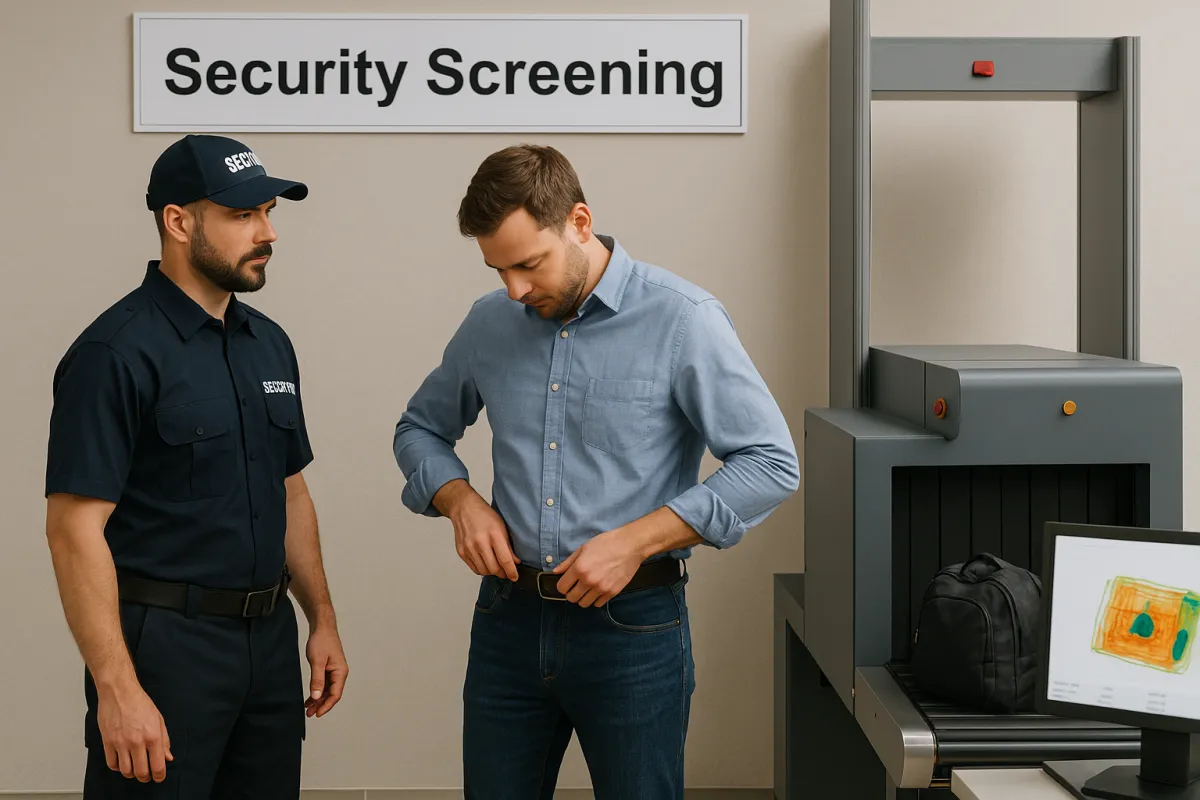Blog & News

Security Screening: Ensuring Safe and Secure Environments
Security Screening: Ensuring Safe and Secure Environments
Effective security screening is the frontline defense for any organization that manages access to sensitive areas or large populations. Whether at corporate headquarters, airports, manufacturing plants, or special events, a well-designed screening program deters threats, prevents unauthorized access, and protects people and assets. At Steel Bison Security, we develop tailored screening solutions—combining policy, process, and technology—to meet your unique risk profile.
1. What Is Security Screening?
Security screening refers to the systematic evaluation of individuals, vehicles, baggage, or data before granting access to a controlled area or system. It encompasses both physical screening—such as metal detectors and bag searches—and digital screening—including background checks and network access controls. The goal is to identify and mitigate potential threats while balancing operational efficiency and the visitor experience.
2. Why Security Screening Matters
2.1. Threat Deterrence & Detection
Visible screening procedures discourage hostile actors. Studies show that the presence of walk-through metal detectors and uniformed officers reduces weapon-related incidents by up to 80% citeturn0news6.
2.2. Regulatory Compliance
Many sectors require mandatory screening to meet legal standards:
Aviation: The Transportation Security Administration (TSA) enforces passenger and baggage screening under 49 CFR § 1540.
Healthcare: The Joint Commission mandates regular staff background checks for patient safety.
Education: Schools follow guidelines from the U.S. Department of Education on visitor screening to protect students.
2.3. Liability Reduction
Failure to screen effectively can lead to negligence claims if prohibited items or dangerous individuals gain access. A documented screening program demonstrates due diligence and can limit legal exposure.
2.4. Enhanced Operational Continuity
Proactive screening prevents disruptions—from small theft to active threats—that can halt operations, damage equipment, or injure people, thereby ensuring business continuity.
3. Types of Security Screening
Physical Screening: Metal detectors, X-ray machines, pat-downs, bag searches.
Personnel Screening: Background checks, credential verification, drug and alcohol testing.
Vehicle Screening: Under-vehicle inspections, license plate recognition, checkpoint barriers.
Digital Screening: Network access controls, multi-factor authentication, security questionnaires.
Automated vs. Manual: Balancing human judgment with automated detection systems.
Each type must be tailored to the threat level, site layout, and user population.
4. Core Components of a Screening Program
A robust program integrates the following:
Policy Framework: Clearly defined policies outlining who to screen, how often, and under what circumstances.
Standard Operating Procedures (SOPs): Step-by-step guides for each screening method, ensuring consistency.
Trained Personnel: Screeners certified in equipment use, behavioral detection, and legal constraints.
Technology & Equipment: Selection of appropriate machines, software, and tools.
Data Management: Secure capture, storage, and disposal of personal and screening data in line with GDPR or CCPA.
Quality Assurance: Regular audits, performance metrics, and continuous training to refine processes.
5. Physical Screening Methodologies
5.1. Walk-Through Metal Detectors (WTMD)
Detects metallic objects on the person.
Calibration & Sensitivity: Adjust settings to balance detection rates with false alarms.
5.2. Handheld Metal Detectors
Used for secondary screening or perimeter patrols.
Ideal for quick checks and high-traffic scenarios.
5.3. X-Ray and Millimeter-Wave Scanners
Baggage Scanning: Identifies concealed objects in bags; mandated in airports and courthouses.
Body Scanners: Advanced Imaging Technology (AIT) scanners detect non-metallic threats under clothing while preserving privacy.
5.4. Pat-Downs and Physical Searches
Protocol-Driven: Must follow policies from OSHA and local labor laws to respect personal rights and minimize liability.
Privacy Considerations: Conducted by same-gender officers in a private area.
5.5. Under-Vehicle Inspection Systems (UVIS)
Cameras and mirrors for checking vehicle undercarriages at secure facilities such as government buildings or critical infrastructure.
6. Digital and Cyber Screening
6.1. Background Checks
Criminal History: National and state databases; continuous monitoring services alert to new convictions.
Employment Verification: Confirm prior work history and references.
Education Verification: Ensure credentials for sensitive roles (e.g., IT administrators).
6.2. Identity Verification
Biometrics: Fingerprint, facial recognition, or iris scans to confirm identity.
Document Authentication: Scanning and validating passports or driver’s licenses against real-time watchlists.
6.3. Network Access Controls
MFA (Multi-Factor Authentication): Combines something you know (password), have (token), or are (biometric).
Role-Based Access Control (RBAC): Limits permissions based on job function.
Privileged Access Management (PAM): Controls and audits administrator-level access to critical systems.
6.4. Pre-Employment Questionnaires
Screens for national security or insider threat indicators (e.g., NIST SP 800-115 guidelines for insider threat mitigation).
7. Regulatory & Legal Considerations
7.1. Aviation Security (TSA)
Comply with the Aviation and Transportation Security Act for passenger screening, banned items lists, and checkpoint protocols.
7.2. Healthcare & Patient Privacy
Adhere to HIPAA Security Rule when capturing visitor logs in clinical settings; limit PHI exposure.
7.3. Workplace Safety (OSHA)
Implement OSHA’s workplace violence guidelines and ensure screening does not violate labor laws or union agreements.
7.4. Data Protection (GDPR/CCPA)
Provide clear notice of data collection and retention schedules.
Offer opt-out or deletion mechanisms.
Ensure encrypted storage and controlled access to visitor and employee screening data.
7.5. Discrimination Risks
Avoid profiling based on race, religion, or other protected characteristics.
Use objective criteria in SOPs and automated systems to reduce bias.
8. Designing an Effective Screening Workflow
8.1. Pre-Arrival Evaluation
Online Pre-Registration: Collect traveler or visitor information to screen against watchlists before arrival.
Automated Watchlist Checks: Integrate with government or commercial databases to flag high-risk individuals.
8.2. Arrival & Initial Screening
Queue Management: Barriers and signage guide people to appropriate lanes (e.g., crew, VIPs, general public).
Signage & Instructions: Clear directions for removing belts, watches, and electronics before WTMD.
8.3. Secondary Screening Triggers
WTMD Alarms: Protocols for follow-up with handheld devices.
Behavioral Detection: Trained officers observe cues such as excessive perspiration or evasive behavior; guided by Behavior Detection techniques.
8.4. Escalation Pathways
Level 1: Secondary screening by another officer.
Level 2: Pat-down or bag search.
Level 3: Supervisor intervention or law enforcement involvement.
8.5. Clearance & Entry
Badge Issuance: Time-limited passes printed via kiosk or manual system.
Digital Records: Automatic logging of screening events—timestamps, officer ID, and outcome.
9. Technology & Innovation in Screening
9.1. AI & Video Analytics
Behavioral Analytics: Software like BriefCam or Avigilon detect anomalies (loitering, tailgating) in real time.
Facial Recognition: Rapid ID checks at secure sites—approved by or compliant with NIST Face Recognition Vendor Test.
9.2. Contactless Screening
Millimeter-Wave Scanners: Non-ionizing radiation for clothing-penetrating scans.
RFID Badge Readers: Contactless gate access reducing queuing times and touchpoints.
9.3. Mobile & Remote Screening
Mobile ID Scanners: Officers carry devices to verify credentials in roving patrols.
Cloud-Based Dashboards: Centralize access control logs, camera feeds, and watchlist alerts—accessible on any device.
9.4. Integrated Solutions
PSIM Platforms: Aggregate screening alarms, camera events, and access logs into unified dashboards for holistic situational awareness.
10. Training, Quality Assurance & Continuous Improvement
10.1. Initial and Refresher Training
Equipment Operation: WTMD, X-ray machines, handheld wands.
Behavior Detection & Customer Service: Combining vigilance with hospitality.
Legal & Ethical Standards: Respect for privacy, non-discrimination practices, and use-of-force limits.
10.2. Performance Metrics & KPIs
Screening Throughput: Average processing time per person.
Alarm Rate & False Alarms: Ratio of genuine threats detected to nuisance alerts.
Compliance Audits: Random spot-checks of SOP adherence.
Customer Feedback: Surveys to gauge stress levels and satisfaction.
10.3. After-Action Reviews
After any security incident or drill, conduct a structured debrief to update procedures, retrain staff, and revise equipment settings or layouts.
11. Future Trends in Security Screening
Biometric Fusion: Combining face, iris, and gait analysis for seamless identity verification.
Predictive Risk Modeling: AI systems that forecast threat likelihood based on historical and real-time data.
Robotic Patrols & Drones: Autonomous screening of perimeters and large campuses.
Augmented Reality (AR) Training: Immersive simulations for officer training on complex scenarios.
Blockchain for Credential Verification: Immutable visitor logs and certificate validation without centralized databases.
Staying ahead of these trends ensures your screening program remains both effective and efficient.
12. How Steel Bison Security Can Help
At Steel Bison Security, we deliver end-to-end screening solutions:
Risk-Based Program Design: Customized screening protocols based on your threat profile.
Technology Selection & Deployment: From walk-through metal detectors to AI-powered analytics.
Staff Training & Certification: Comprehensive courses in equipment operation, behavior detection, and legal compliance.
Ongoing Quality Assurance: Regular drills, audits, and performance reporting.
Integrated Command & Control: Centralized dashboards for real-time monitoring and rapid incident coordination.
Visit our contact page to schedule a consultation and safeguard your organization with best-in-class screening practices.
13. Conclusion
Security screening is a critical pillar of any comprehensive security strategy. By combining rigorous policies, well-trained personnel, advanced technology, and continuous improvement, you can deter threats, enhance visitor satisfaction, and ensure compliance with legal and industry standards. Whether you manage an airport, corporate campus, healthcare facility, or event venue, partnering with Steel Bison Security ensures your screening program is robust, scalable, and future-ready.
Protect your people and assets—invest in a comprehensive security screening program today.

EMAIL ADDRESS
OFFICE NUMBER
OFFICE ADRESS
(WA) 11900 NE First St STE 3066, Bellevue, Wa 98005
(WY) 30 N. Gould St STE R, Sheridan, Wy 82801
Copyright 2024 Steel Bison Security Services
